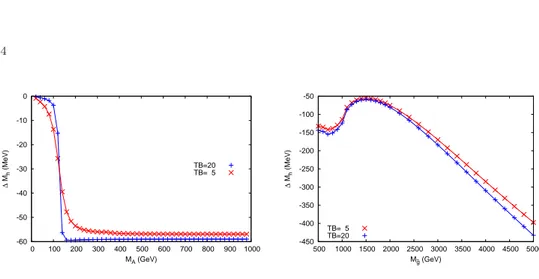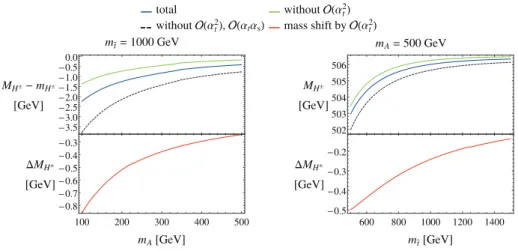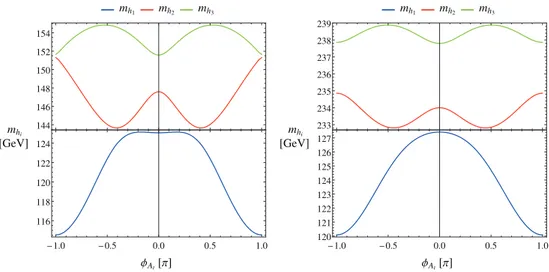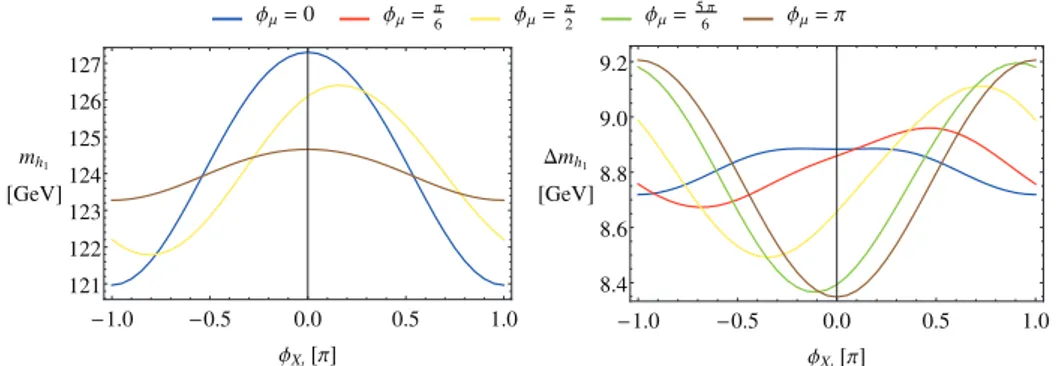Precision Calculations for Supersymmetric Higgs Bosons
W. Hollik
Max Planck Institute for Physics, F¨ohringer Ring 6, 80805 Munich, Germany
E-mail: hollik@mpp.mpg.de www.mpp.mpg.de
Recent progress is presented on higher-order calculations for the mass spectrum of Higgs particles in the CP-conserving and CP-violating MSSM, covering diagrammatic two-loop calculations for neutral and charged Higgs bosons as well as all-order resummation of large logarithms arising from the strong and Yukawa coupling sectors.
Keywords: Higgs bosons; MSSM; higher order calculations; mass spectrum.
1. Introduction
The neutral Higgs-like particle with a mass at 125 GeV, discovered by the ATLAS and CMS experiments
1,2, behaves within the presently still sizeable experimental uncertainties like the Higgs boson of the Standard Model (see
3for the latest results), but on the other hand leaves ample room for interpretations within extended models with a richer spectrum. A scenario of particular interest thereby is the Minimal Supersymmetric Standard Model (MSSM) with two scalar doublets accommodating five physical Higgs bosons, at lowest order given by the light and heavy CP -even h and H , the CP -odd A, and the charged H
±Higgs bosons. At lowest order, their masses can be parametrized in terms of the A-boson mass M
Aand the ratio of the two vacuum expectation values, tan β ≡ v
2/v
1. Higher-order contributions, however, give in general substantial corrections to the tree-level relations. A review of the calculations and an illustration of the recent results are presented in this talk.
2. The Higgs-boson masses of the MSSM
The parameters entering the MSSM Higgs-boson spectrum at lowest order can be chosen as the gauge-boson masses M
W,Z, the mass M
A, and tan β. The other neutral and charged Higgs-boson masses are predicted in terms of these quantities:
m
2H±= M
A2+ M
W2, (1)
m
2h, H= 1 2
M
A2+ M
Z2∓ q
(M
A2+ M
Z2)
2− 4M
A2M
Z2cos
2(2β)
. (2)
Higher-order contributions, however, give in general substantial corrections to the
tree-level relations, with the dominant one-loop terms arise from the Yukawa sector.
However, all the other sectors of the MSSM also contribute in a non-negligible way in particular to the mass of the lightest Higgs particle, making thus m
ha valuable observable that is sensitive to the still unknown SUSY particles. Precision tests of the MSSM will therefore require precise calculations of the mass spectrum including higher-order terms.
3. Higher-order calculations for the Higgs-boson masses
The status of higher-order corrections to the masses and mixing angles in the neutral Higgs sector is quite advanced. A remarkable amount of work has been done for higher-order calculations of the mass spectrum, for real SUSY parameters
4–18as well as for complex parameters
19–25. They are based on full one-loop calculations improved by higher-order contributions to the leading terms from the Yukawa sector involving the top and bottom Yukawa couplings α
t, α
band the strong coupling constant α
s. Recently, also the O α
2tterms for the complex version of the MSSM were computed
24,25. All the available higher-order terms have been implemented into the public program FeynHiggs
26–28.
Also the mass of the charged Higgs boson is affected by higher-order corrections when expressed in terms of M
A. The status is, however, somewhat less advanced as compared to the neutral Higgs bosons. Approximate one-loop corrections were already derived in
29–31. The first complete one-loop calculation in the Feynman- diagrammatic approach was done in
32, and more recently the corrections were re- evaluated in
23,33,34. At the two-loop level, important ingredients for the leading corrections are the O(α
tα
s) and O α
2tcontributions to the charged H
±self-energy.
The O(α
tα
s) part was obtained in
22for the complex MSSM, where it is required for predicting the neutral Higgs-boson spectrum in the presence of CP -violating mixing of all three neutral CP eigenstates and the charged Higgs-boson mass used as an independent (on-shell) input parameter instead of M
A. In the CP -conserving case, on the other hand, with M
Aconventionally chosen as an independent input quan- tity, the corresponding self-energy contribution has been exploited for obtaining corrections of O(α
tα
s) to the mass of the charged Higgs boson
34. In an analo- gous way, the recently calculated O(α
2t) part of the H
±self-energy in the complex MSSM
24,25, hasbeen utilized for the real, CP -conserving, case to derive the O(α
2t) corrections to the charged Higgs-boson mass as well
35.
4. The spectrum of the real MSSM
A higher-orders, replacing (2), the masses M
hand M
Hof the neutral Higgs-bosons are obtained from the poles of the propagator matrix ∆(q
2) dressed by the diagonal and non-diagonal self-energies,
∆(q
2)
−1= q
2− m
2H+ ˆ Σ
H(q
2) Σ ˆ
hH(q
2) Σ ˆ
Hh(q
2) q
2− m
2h+ ˆ Σ
h(q
2)
!
, (3)
where the self-energies ˆ Σ have been renormalized by adding the appropriate coun- terterms. As far as the Higgs sector is concerned, the parameters M
Aand tan β acquire renormalization, providing the counterterms δM
A2and δ tan β. In the hy- brid on-shell/DR scheme, they are obtained from the (unrenormalized) A-boson self-energy and the DR field-renormalization constants of the two Higgs doublets,
δM
A2= Σ
A(M
A2), δ tan β = tan β δZ
H2− δZ
H1, (4) preserving the mass M
Aas the on-shell mass of the neutral A boson. Moreover, the loop contributions to the one-point functions, the h, H tadpoles, have to be canceled by tadpole counterterms δT
h, δT
Hensuring the vacua v
1, v
2to remain the true vacua also at higher orders:
T
h+ δT
h= 0 , T
H+ δT
H= 0 . (5)
4.1. Two-loop momentum-dependent self-energies
In most of the higher-order calculations mentioned above, the self-energies beyond one loop are evaluated for vanishing external momenta, either in the Feynman- diagrammic approach or applying the effective-potential method. Going beyond the zero-momentum approximation, the momentum-dependence of the self-energies and the impact on the masses of h and H were obtained
9at O(α
tα
s) for the real MSSM in the on-shell/DR renormalization scheme as described above extended to the two- loop order. As a new element, one-loop subrenormalization (Fig. 1) is required for the colored sector of O(α
s): for the top-quark and top-squark masses as well as the trilinear coupling A
t, with counterterms determined by on-shell conditions as formulated e.g. in
22. In addition, a calculation with the colored sector renormalized in the DR scheme was performed in
10. For illustration of the effects we display in Fig. 2 the mass shift ∆M
hof the h boson resulting exclusively from the q
2- dependence of the two-loop O(α
tα
s) part of the self-energies in (3), versus M
Aand the gluino mass M
g˜, as obtained in
9for the M
hmaxscenario
36.
So far:
• top-quark pole mass chosen as input parameter
t
t
φ t φ
(a)
t
φ φ
t
(b)
˜ ti
˜ tj
φ ˜ti φ
(c)
˜ tj
φ φ
t˜i
(d)
˜ ti
φ φ
(e)
˜ ti
φ φ
˜ ti
(f)
˜ ti
φ
(a)
˜ tj φ
˜ ti
(b)
t φ
(c)
t φ
t
(d)
Fig. 1. Two-loop diagrams with one-loop counterterm insertions (φ=h, H, A)
-60 -50 -40 -30 -20 -10 0
0 100 200 300 400 500 600 700 800 900 1000
∆ Mh (MeV)
MA (GeV)
TB=20 TB= 5
-450 -400 -350 -300 -250 -200 -150 -100 -50
500 1000 1500 2000 2500 3000 3500 4000 4500 5000
∆ Mh (MeV)
M~g (GeV) TB= 5
TB=20
Fig. 2. Mass shift of thehboson arising from the two-loopO(αtαs) momentum dependence, for tanβ= 5 and 20 in theMhmaxscenario. Mg˜= 1500 GeV (left),MA= 250 GeV (right).
4.2. Resummation of large logarithms
For high SUSY-breaking mass scales M
Sin the scalar-quark sector, the logarith- mically enhanced loop contributions ∼ α
tL, α
2tL
2, α
tα
sL
2, α
2tL, α
tα
sL, · · · , with L = log M
S2/m
2t, constitute the dominant part of the higher-order corrections
∆M
h2to the light Higgs-boson mass and have to be taken into account beyond the two-loop level for a reliable prediction. The fixed-order result obtained by the diagrammatic calculation, as available via FeynHiggs, has been combined
37with an all-order resummation of the leading and subleading logarithmic contributions from the top/stop sector, derived via renormalization group equations for α
t, α
s, and the quartic Higgs coupling in the Standard Model as the effective theory below the large scale M
S≫ M
Z(see also
38,39for similar RGE studies).
5000 10000 15000 20000
MS [GeV]
115 120 125 130 135 140 145 150 155
Mh [GeV]
FH295 3-loop 4-loop 5-loop 6-loop 7-loop LL+NLL
FeynHiggs 2.10.0
Xt = 0 Xt/MS = 2
Fig. 3. Mhas a function ofMS for unmixed top-squarks (Xt = 0) and forL-Rmixed squarks withXt/Ms= 2 (Xt=At−µcotβ): Full result (LL+NLL) compared with the fixed-order result of FeynHiggsand with 3-loop,. . . higher-order results containing the logarithmic contributions.
tanβ= 10, MA=M2=µ= 1000 GeV, M˜g= 1500 GeV.
In the combination of the logarithmic contributions obtained from solving the RGEs with the fixed-order result in FeynHiggs, double counting has to be avoided for the logarithmic contributions up to the two-loop level and the different schemes (on- shell versus MS) employed in the diagrammatic and RGE approach have to be taken into account by converting the parameters properly. Fig. 3 illustrates the strong impact of the resummation for large SUSY scales.
4.3. The M
H±− M
Acorrelation at two-loop order
In the real MSSM, the mass M
Aof the CP -odd A boson is conventionally chosen as a free input parameter, fixing also the mass of the charged Higgs boson uniquely at lowest order by eq. (1). The correlation between the two masses is a decisive feature of the MSSM and thus phenomenologically important for testing the model;
it is, however, subject to loop corrections as well, yielding the charged on-shell mass via M
H2±= m
2H±+ ∆M
H2±with the correction ∆M
H2±derived from the charged Higgs-boson self-energy. At present, the renormalized self-energy,
Σ ˆ
H±(q
2) = ˆ Σ
(1−loop)H±(q
2) + ˆ Σ
(αH±tαs)(0) + ˆ Σ
(α2 t)
H±
(0) , (6) contains the full one-loop result and the leading two-loop terms from the Yukawa and strong interactions in the zero-momentum approximation
34,35renormalized in the on-shell scheme. Thereby, the subloop renormalization for the colored sector is performed as in Section 4.1 at O(α
s), and augmented to O(α
t) as described in
25. The numerical impact of the various higher-order terms are illustrated in Fig. 4.
More details can be found in
35.
total withoutOHΑ
t 2L withoutOHΑt2L,OHΑtΑsL mass shift byOHΑt2L mt=1000 GeV
100 200 300 400 500
-0.8 -0.7 -0.6 -0.5 -0.4 -0.3
mA@GeVD DMH±
@GeVD -3.5 -3.0 -2.5 -2.0 -1.5 -1.0 -0.5 0.0
D MH±-mH±
@GeVD
mA=500 GeV
600 800 1000 1200 1400 -0.5
-0.4 -0.3 -0.2
mt@GeVD DMH±
@GeVD 502 503 504 505 506
D MH±
@GeVD
D D
D D
Fig. 4. Charged Higgs-boson massMH± with all available terms and mass shift ∆MH± exclu- sively fromO(α2t). tanβ= 10, Mg˜= 1500 GeV, µ= 2000 GeV, At= 1.5mt˜.
5. The spectrum of the complex MSSM
At lowest order, the MSSM Higgs sector is CP conserving; CP -violation ist induced via loop contributions involving complex parameters from other SUSY sectors lead- ing to mixing between h, H and A in the mass eigenstates
40. The propagator matrix for the neutral Higgs fields becomes a 3 × 3 matrix, augmenting (3) by the diagonal and non-diagonal self-energies ˆ Σ
{A,Ah,AH}, from which the masses are obtained via the real parts of the complex poles. Differently from the real MSSM, M
Acannot be used as an input parameter; instead, the charged Higgs-boson mass M
H±is used, which can be renormalized independently by an on-shell condition replacing the condition for M
Ain (4). Moreover, a third tadpole condition for the A-field with an independent counterterm δT
Ahas to be added to the set (5). The self-energies in the complex MSSM are completely known at the one-loop level
23and presently include the leading O(α
tα
s) and O(α
t2) contributions in the approximation of zero external momentum
22,24,25.
The mass eigenvalues show a significant dependence on the phases of the SUSY parameters, especially of A
tand µ. The variation of the spectrum with the phase φ
At(and other parameters real) is illustrated in Fig. 5, showing mass shifts of typically 5 GeV . For φ
At6= 0, the lightest Higgs particle remains almost completely CP -even, whereas the two heavier ones develop large CP mixing
25. This is of particular interest for m
h1≃ 125 GeV, where h
1is Standard-Model like, but the features of the heavier Higgs bosons deviate substantially from those of the real MSSM.
Also the coefficient of the bilinear term of the superpotential, the Higgsino mass
mh
1 mh
2 mh
3
mh
i
@GeVD
-1.0 -0.5 0.0 0.5 1.0
116 118 120 122 124 144 146 148 150 152 154
ΦAt@ΠD
mh
1 mh
2 mh
3
mh
i
@GeVD
-1.0 -0.5 0.0 0.5 1.0
120 121 122 123 124 125 126 127 233 234 235 236 237 238 239
ΦAt@ΠD
Fig. 5. The neutral Higgs-boson mass eigenvaluesmh1, mh2, mh3: dependence on the phase of the complex At parameter. Left: MH± = 170 GeV, right: MH± = 250 GeV. The other parameters are: tanβ= 10, mt˜= 1500 GeV,|At|= 2m˜t, µ= 2500 GeV, Mg˜= 1500 GeV.
ΦΜ=0 ΦΜ=Π6 ΦΜ=Π2 ΦΜ=5Π6 ΦΜ= Π
-1.0 -0.5 0.0 0.5 1.0
121 122 123 124 125 126 127
ΦXt@ΠD mh1
@GeVD
-1.0 -0.5 0.0 0.5 1.0
8.4 8.6 8.8 9.0 9.2
ΦXt@ΠD Dmh1
@GeVD
Fig. 6. Dependence of the lightest neutral Higgs-boson mass on the phasesφXt andφµ. Left:
Prediction formh1 including all available contributions, with the phase dependence arising from one-loop, O(αtαs) andO α2t
terms. Right: The contribution ∆mh1 tomh1 owing exclusively to theO α2t
terms, for different phases. The input parameters areMH±= 200 GeV, tanβ= 10,
|µ|= 2500 GeV,m˜t= 1500 GeV,|Xt|= 2m˜t,Mg˜= 2000 GeV.




